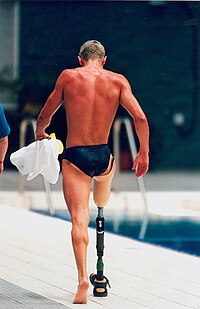
Photo from wikipedia
Background: Designed by Dr. Sethi, the Jaipur Foot prosthesis is ideally suited for amputees in developing countries as it utilizes locally sourced, biodegradable, inexpensive materials and is focused on affordability… Click to show full abstract
Background: Designed by Dr. Sethi, the Jaipur Foot prosthesis is ideally suited for amputees in developing countries as it utilizes locally sourced, biodegradable, inexpensive materials and is focused on affordability and functionality. To date, however, no data have been reported on the material properties of the foot components. Objectives: The goal of this work was to evaluate mechanical properties of the Jaipur Foot components to guide foot design and manufacturing and reduce weight. Study Design: Experimental. Methods: Mechanical testing was conducted on two types of woods (ardu and cheed), microcellular rubber, tire cord, cushion compound, tread compound, and skin-colored rubber. Each material was subjected to testing in either tension or compression based on its location and function in the foot. Samples were tested before and after vulcanization. Two-sample t-tests were used to assess statistical differences. Results: Cheed compressed perpendicular to the grain had a significantly higher modulus of elasticity than ardu (p < 0.05); however, cheed had a higher density. Vulcanization significantly increased the modulus of skin-colored rubber, cushion compound, and tread compound (p < 0.05) and decreased the moduli of both microcellular rubber and tire cord (p < 0.05). Conclusion: The material property results from this study provide information for computer modeling to assess material construction on overall foot mechanics for design optimization. Ardu wood was ideal based on the desire to reduce weight, and the tire cord properties serve well to hold the foot together. Clinical relevance With new knowledge on the material properties of the components of the Jaipur Foot, future design modifications and standardized fabrication can be realized, making the Jaipur Foot more available on a global scale.
Journal Title: Prosthetics and Orthotics International
Year Published: 2018
Link to full text (if available)
Share on Social Media: Sign Up to like & get
recommendations!